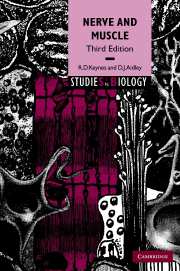Book contents
- Frontmatter
- Contents
- Preface
- Publishers note
- 1 Structural organization of the nervous system
- 2 Resting and action potentials
- 3 The ionic permeability of the nerve membrane
- 4 Membrane permeability changes during excitation
- 5 Voltage-gated ion channels
- 6 Cable theory and saltatory conduction
- 7 Neuromuscular transmission
- 8 Synaptic transmission in the nervous system
- 9 Skeletal muscles
- 10 The mechanism of contraction in skeletal muscle
- 11 Non-skeletal muscles
- Further reading
- References
- Index
7 - Neuromuscular transmission
Published online by Cambridge University Press: 05 June 2012
- Frontmatter
- Contents
- Preface
- Publishers note
- 1 Structural organization of the nervous system
- 2 Resting and action potentials
- 3 The ionic permeability of the nerve membrane
- 4 Membrane permeability changes during excitation
- 5 Voltage-gated ion channels
- 6 Cable theory and saltatory conduction
- 7 Neuromuscular transmission
- 8 Synaptic transmission in the nervous system
- 9 Skeletal muscles
- 10 The mechanism of contraction in skeletal muscle
- 11 Non-skeletal muscles
- Further reading
- References
- Index
Summary
Skeletal muscles are innervated by motor nerves. Excitation of the motor nerve is followed by excitation and contraction of the muscle. Thus excitation of one cell, the nerve axon, produces excitation of another cell which it contacts, the muscle fibre. The region of contact between the two cells is called the neuromuscular junction. The process of the transmission of excitation from the nerve cell to the muscle cell is called neuromuscular transmission. This chapter is concerned with how this process occurs.
Regions at which transfer of electrical information between a nerve cell and another cell (which may or may not be another nerve cell) occurs are known as synapses, and the process of information transfer is called synaptic transmission. Neuromuscular transmission is just one form of synaptic transmission; we shall examine the properties of some other synapses in the following chapter.
The neuromuscular junction
Each motor axon branches so as to supply an appreciable number of muscle fibres. Fig. 7.1 shows the arrangement in most of the muscle fibres in the frog. Each axon branch loses its myelin sheath where it contacts the muscle cell and splits up into a number of fine terminals which run for a short distance along its surface. The region of the muscle fibre with which the terminals make contact is known as the end-plate. Structures and events occurring in the axon are called presynaptic whereas those occurring in the muscle cell are called post-synaptic.
- Type
- Chapter
- Information
- Nerve and Muscle , pp. 86 - 102Publisher: Cambridge University PressPrint publication year: 2001

